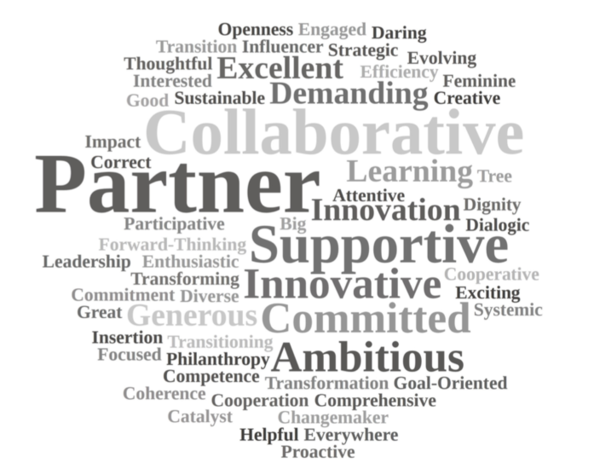It Starts with Trust: C&A Foundation’s Response to our Partner Survey
Last year, we commissioned the Center for Effective Philanthropy (CEP) to survey our partners in order to understand where we – as C&A Foundation – could improve. Our survey followed an established methodology (CEP’s Grantee Perception Report) which has been used by over 300 foundations worldwide. This was the second time we commissioned such a survey (the first being in 2016 and found here) and we are grateful for the 86 partners (a 74% response rate) who took the time to share thoughtful insights and ways we could improve.

Overall, these insights have been extremely motivating. When asked “what one word best describes the foundation,” our partners shared many positive views (from “collaborative” to “committed” to “ambitious”) as the word cloud shows. I am proud that our partners see us as a supportive, innovative changemaker. But they also flagged some areas of improvement, calling out, in particular, our sometimes “demanding” nature.
In fact, this second Partner Perception Report comes at an opportune time. As we retire C&A Foundation and begin to build Laudes Foundation, we are also working to strengthen our operating model. This includes reviewing our overall grant lifecycle – from initial concept to final evaluation – and identifying ways to make it more efficient, effective and ultimately less onerous on our partners.
In our 2019 Annual Report, we share some of the key recommendations from this second Partner Perception Report, which I group into four themes. A more detailed management response (with the actions we are taking) is found here.
Deepen trust. When we launched C&A Foundation in 2014, we did so with a moonshot ambition: to transform the global fashion industry. To guide our efforts, we developed and refined our theory of change which helped to guide our strategic choices over the past five years. Having such a clear strategy helped us to focus – and stay focused – on our end game. But it also meant that we did not always incorporate the input of our partners, who bring decades of learning, experience, and nuance to the deep, systemic issues we were trying to solve. As one survey respondent advised us, “Be more open to co-create with investees, take time to listen, trust the experience of the investee, challenge constructively rather than impose.” This is excellent advice, and we are working across our teams to incorporate more dialogue and shared learning in how we operate.
Strengthen the core. We know foundations can serve their partners beyond the deployment of financial resources. Building on a strength first identified in our 2016 survey, more than a quarter of our partners – a larger than average proportion – reported receiving intensive patterns of non-monetary assistance from C&A Foundation. This is good. However, we lag behind other donors when it comes to providing unrestricted funding; only seven percent of our partners report receiving general operating or core support (compared to 29 percent of partners at the typical funder.) Given our focus on systems change, we are stepping up and helping to strengthen those frontline responders – many of whom are grassroots organisations - and this means increasing the level of core (rather than programmatic) support we provide.
Build the field. While we have been recognised for our unique position in working to make fashion a force for good (and our teams were rated as having above-average awareness of the challenges partners face), our partners shared that we could do more to impact the broader field, including stepping up to better influence public policy. As a result, we are increasing our efforts to encourage learning and growth across our partners by, for example, offering a Learning Fund for partners to connect with each other and committing to continue hosting our all-partners meeting every three years (with the next taking place in 2021). And, in light of our desire to “build back better” in the wake of the Covid-19 pandemic, we are redoubling efforts to support a more enabling environment (and the policies which create incentives for the change we want to see).
Simplify processes. The median number of hours spent by our partners on “funder requirements over the grant lifetime” has doubled since 2016 (120 hours vs. 70 hours in 2016). To me, this is unacceptable. We are simplifying these requirements to reduce the burden on our partners. We are also enabling more inclusion of strong, grassroots partners who may not have been able to meet our previous funding criteria (e.g., proposals in English only) but are strong and effective implementers. Our global operations team is leading a consultative process in 2020 to redesign (and simplify) how partners can access funding.
While all of these actions are underway, we have recently had the opportunity to test more responsive (and administratively lighter) approaches with our partners. With the onset of the Covid-19 pandemic, we launched an Emergency Fund to provide core support with streamlined paperwork to many of our trusted partners. In less than one month, we designed, implemented, and dispersed EUR 3.5 million, as well as non-financial support in crisis management, to our partners. This not only helped many of them “keep their lights on” but also provided critically needed support to over 500,000 vulnerable workers, farmers and their families. Simplified processes, in this case, helped to enable more effective outcomes.
So it is possible to be rigorous, but not onerous. And as we build Laudes Foundation, we will continue to strengthen those weaker areas flagged by our partners. We hope to see the results of these improvements when, in 2022, we commission our third Partner Perception Report.

